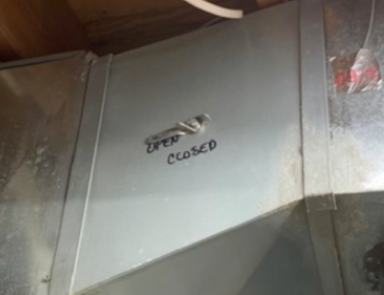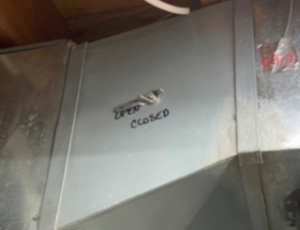Where do you find the dampers in your house?

If you live in an area like us (Olathe, KS) that has drastic changes in the seasonal temperatures, your home probably has dampers. Dampers allow you to push more (or less) air to a specific part of your home.
In most homes there is a damper on the ductwork “run” that goes to the upstairs portion of the home and a separate run that services the lower levels.
The dampers are going to be in the ductwork near your furnace.
Above your typical furnace there is a plenum. That is the sheet metal that goes straight up off the top of the cooling coil. From there you can see that there is a duct going to the right and there’s one going to the left.
The damper is commonly located close to the plenum in the center of the ductwork.
What does the damper look like on the ductwork?
When you go to the plenum near your furnace, look up at the ductwork and see if you can find something that looks like a screw or a wing nut. Some may have a little handle attached, but others just have what looks like a wing nut coming from the center of the ductwork.
The wing nut and the stem is the very center of the damper. In the center of the wing nut you should see a flat spot. The flat spot is indicating the position of the damper.
Inside the duct work there’s a damper that is turned either horizontal or vertical. The damper is just a piece of sheet metal that can block airflow.
The position of the flat spot in the middle of the wing nut is indicating if the damper is in a horizontal or vertical position. If it is vertical the damper will be blocking airflow and if it is horizontal it will be “open” allowing air to freely pass through.
In order to adjust the damper position, loosen the wing nut. You may need a pair of pliers. After you loosen the wing nut, get ahold of that flat stem and adjust the position. Hold it in the new position and tighten the wing nut back down until it feels solid and in place.
Are dampers in every home?
Typically, yes there are dampers in most homes. However there are times where they don’t install them when the home is originally built. They can be added later to allow for the capability of adjusting the airflow.
If you are in the Olathe, KS area (anywhere in Johnson County, KS) and are interested in installing dampers in your home, please schedule an appointment for a FREE ESTIMATE here: SCHEDULE APPOINTMENT TO ADD DAMPERS




